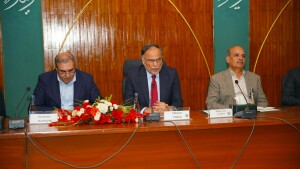Lotte Chemical Pakistan Limited (LCPL) is the manufacturer and supplier of Purified Terephthalic Acid (PTA). PTA is the primary raw material for producing polyester fibre, polyester filament yarn, polyester film and Polyethylene Terephthalate (PET). PTA is used in Pakistan's textile and packaging industries as it is an essential raw material for the polyester chain.
The company was originally a part of ICI Pakistan Limited. It was demerged from ICI Pakistan Limited in 2000 into Pakistan PTA Limited (PPTA). In 2009, the firm was acquired by South Korean based company KP Chemical Corp (a subsidiary of Lotte International), and the name changed to Lotte Pakistan PTA Ltd. In 2012, a co-generation plant was commissioned in Pakistan, and KP Chemical Corp changed its identity globally to Lotte Chemical Corp, and hence the name changed to Lotte Chemical Pakistan Ltd.
LCPL has the capacity to produce approximately 500,000 tons of PTA per year through its plant located at Port Qasim, Karachi. Besides meeting Pakistan's PTA demand, the company is well placed to export to other countries. For producing PTA, it imports its feedstock (Paraxylene) from suppliers based in Asia and Middle-East region. As per Company its product meets all international quality standards and is well accepted by Customers in Asia and Middle-East region.
Pakistan's chemical sector
As per industry reports, the global chemical product market is expected to get double by 2035.Despite the fact that the growth prospective are quite good and healthy, but the industry's dynamism is set to wane. The market is growing at an average annual pace of four percent at the moment; this will expand the chemicals market by just 3.6 percent per annum between 2030 and 2035. The chemical industry is a major contributor to the world's economy where the annual consumption of chemicals stands out at $4.6 trillion.


The Asian market, however, is still gaining grounds, and its share of the market is set to rise to 62 percent by 2035. As per Pakistan Chemical Manufacturers' Association, the volume of the Pakistani industry is around $8.5 billion, and it is the biggest sector in Pakistan. Few segments of the Pakistani chemical industry are relatively developed in basic chemicals including fertiliser, oil refining, sulphuric acid, soda ash etc. In the past decade, the industry has also witnessed steady growth in some of the emerging sub-sectors including textile and tanning chemicals, polyester, synthetic fiber, paints, varnishes and miscellaneous coatings.
Shareholding of Lotte
Closely held shares (those held by the sponsors, investment companies, financial institutions, foreign investors and other corporate bodies) amount to 82.57 percent of the total share capital including 75.01 percent held by the foreign shareholders. The primary chunk of this holding of Lotte Chemical Pakistan Limited shares is owned by Lotte Chemical Corporation, South Korea.
Financial performance in 2015
Up till 2010 Lotte Pakistan was enjoying a buoyant cycle, but all has changed since 2011 when the company posted a drop in annual profits as primary margins decreased. Since then the firm has been sustaining losses.
The performance of Lotte Chemical mostly remained unimpressive during the year 2015. The overall PET consumption declined due to the holy month of Ramadan falling in summer, which is usually the peak season for PET demand. On the other hand, the major clientele of the company, polyester staple fibre (PSF) producer has gone through a challenging time during 2015. Similarly, the local bottle industry also introduced lighter bottles (a cost saving measure) that also affected the demand of PET and in return the top line of Lotte Chemical.
The company reported sales of 463,137 tonnes, which was three percent year-on-year lower than 2014. Perhaps because it comprises of only domestic sales; due to the growing competition from China and India, the company was not able to export, and the sales were restricted to the domestic market only.



During the year the firm reported revenue of Rs33,863 million, which is a 29 percent year-on-year decline mainly due to significantly lower PTA prices. It has also suffered the gross loss of Rs257 million for the year as compared to gross loss of Rs1,969 million during the same period last year due to higher PTA margin over PX along with lower variable conversion costs.
Since there were zero exports, the selling and distribution expenses were much lower in 2015 than 2014, while the administrative remained put. The other costs for the year, however, increased mainly due to provision for obsolete, slow moving and redundant stores and spare parts. On the back of lower sales and higher expenses, the company suffered a loss in its bottom line for the year amounted to Rs748 million as compared to the loss of Rs1,100 million, last year.
Snapshot in 2016
Lotte Chemical started the financial year with a loss. Once again the chemical company failed to include exports in its top line, and that continued to affect the fortunes of the firm. However, the domestic sales volume during the first quarter stood at 122,350 tonnes, seven percent higher than the first three months last year. The adverse trading condition for the company, which started in 2014, continued during the period, and Lotto incurred a gross loss during the period.



That said, Lotte is upbeat about rest of the year. The National Tariff Commission has levied Anti-Dumping Duties on PSF from China, during the quarter. Since the imposition of the provisional duties in October of last year, PSF imports from China have steadily declined. It is expecting healthy demand from the downstream PTA industry during the peak summer season. Moreover, PET demand is projected to be strong during the summer months.
Future Outlook
The future of Lotte Chemical depends on multiple issues, and unfortunately all of them are beyond the control of the company. At the moment the market has been over supplied by PTA, and as per the Lotte's director's report, around two million tons of new capacities expected to come online during 2016. The oversupply is creating multiple problems in determining margins and the general health of Lotte. The government should look into the issue of anti-dumping duties on PTA during China, and there is a need to further increase the tariff rates on PTA import in line with the region. Then there is the issue of declining textile exports of Pakistan. Over the years, the textile industry is tumbling and that has put pressure on the margins of the company as well.
The current tariff level does not provide the firm with the ability to sustain major market downturns and is also a major disincentive for further investment and growth of this vital source of raw material for the domestic textile and PET sectors.


























Comments
Comments are closed.